This has been my week for afrobeat and Egypt 80. I reviewed a new release of vintage Fela Kuti earlier this week and last night I got to see his son front that band. What an amazing show!
 I talked to Frank Roddy and Casey Hrdlicka from Atomga before their set. They told me their original intent was to start a Fela Kuti tribute band, but they decided to broaden their vision to a musical sound rooted in afrobeat. They've been making the rounds in Denver, but this was their first time playing at the Boulder Theater and they were excited to be sharing the stage with Egypt 80.
I talked to Frank Roddy and Casey Hrdlicka from Atomga before their set. They told me their original intent was to start a Fela Kuti tribute band, but they decided to broaden their vision to a musical sound rooted in afrobeat. They've been making the rounds in Denver, but this was their first time playing at the Boulder Theater and they were excited to be sharing the stage with Egypt 80.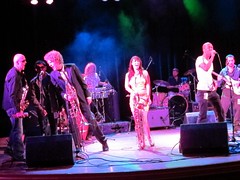 Afrobeat demands a fairly large band. The polyrhythmic beat needs to stand out, which calls for a drummer and at least one percussionist. Guitar and bass are also critical, along with keys if possible. But the crown of any afrobeat band is the horn section. Atomga's line up covered all of this plus a vocalist, filling the stage with eleven musicians.
Afrobeat demands a fairly large band. The polyrhythmic beat needs to stand out, which calls for a drummer and at least one percussionist. Guitar and bass are also critical, along with keys if possible. But the crown of any afrobeat band is the horn section. Atomga's line up covered all of this plus a vocalist, filling the stage with eleven musicians.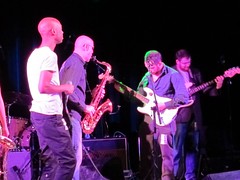 They started the set with their song, Kapital, laying down the beat and letting the horns play the hook. The horn arrangement on the tag had a great Latin vibe. Once the song got underway, the guitar and horns traded off sections in a tight funk groove. When vocalist Devan Blake Jones came in, his smooth voice added a jazzy veneer. Later, Jones proved to be very versatile, shifting from soulful to more reggae style. The backing vocals looked good, but were too hard to hear. The sound engineer should have kicked them up in the mix.
They started the set with their song, Kapital, laying down the beat and letting the horns play the hook. The horn arrangement on the tag had a great Latin vibe. Once the song got underway, the guitar and horns traded off sections in a tight funk groove. When vocalist Devan Blake Jones came in, his smooth voice added a jazzy veneer. Later, Jones proved to be very versatile, shifting from soulful to more reggae style. The backing vocals looked good, but were too hard to hear. The sound engineer should have kicked them up in the mix.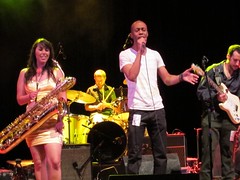 The horns were very tight, showing off some well crafted arrangements. Each player had many chances to show off. While all of the horn players took some great solos, Alekzandor Palesh's trombone stood out. He had a couple of surprising leads that showed some subtlety. Guitarist Casey Hrdlicka was a little more forward than normal for afrobeat, but he had a tasteful touch that emphasized the soul/funk influences on the style.
The horns were very tight, showing off some well crafted arrangements. Each player had many chances to show off. While all of the horn players took some great solos, Alekzandor Palesh's trombone stood out. He had a couple of surprising leads that showed some subtlety. Guitarist Casey Hrdlicka was a little more forward than normal for afrobeat, but he had a tasteful touch that emphasized the soul/funk influences on the style. Any concert performance needs to balance the music with a good entertaining stage presence. Atomga covered this well. They were clearly having a lot of fun and reacted to each other and the crowd. Whether it was Palesh's absorbed dance steps or Bari sax player Leah Concialdi's aura of joy, the band connected well with the audience.
Any concert performance needs to balance the music with a good entertaining stage presence. Atomga covered this well. They were clearly having a lot of fun and reacted to each other and the crowd. Whether it was Palesh's absorbed dance steps or Bari sax player Leah Concialdi's aura of joy, the band connected well with the audience.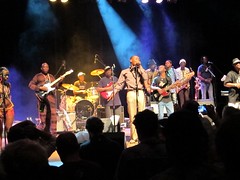 The crowd's excitement built in the interval between the bands. I talked to a couple of people who had seen Fela Kuti back in the '80s and several others like myself who had only heard the recordings.
The crowd's excitement built in the interval between the bands. I talked to a couple of people who had seen Fela Kuti back in the '80s and several others like myself who had only heard the recordings.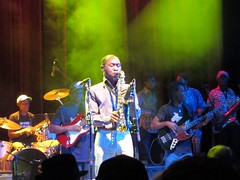 I've seen tribute bands and "classic" reunion bands, but this was different, although the surface seems similar. Like a cross between the two ideas, Seun Kuti leads his father's old band, covering several of the old songs and channeling his father's performance to some extent.
I've seen tribute bands and "classic" reunion bands, but this was different, although the surface seems similar. Like a cross between the two ideas, Seun Kuti leads his father's old band, covering several of the old songs and channeling his father's performance to some extent.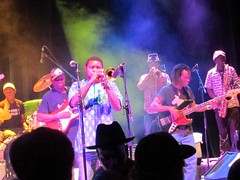 But this wasn't a band trapped in amber or in decay. Instead, they had a vibrant sound, which featured numerous new songs. They also had less emphasis on free jazz than Fela had. Seun may affect some of Fela's mannerisms, but he's not playing a role. He sang. played his sax, and danced with total intensity, carried by the music.
But this wasn't a band trapped in amber or in decay. Instead, they had a vibrant sound, which featured numerous new songs. They also had less emphasis on free jazz than Fela had. Seun may affect some of Fela's mannerisms, but he's not playing a role. He sang. played his sax, and danced with total intensity, carried by the music. Seun didn't come out until the second song and the difference was electric. He strode to center stage with the grace and poise of an athlete. And as the band vamped, he raised his sax to play. That's when the stage energy leaped to a new high. Seun reveled in both the attention and the ecstasy of music. Seun let the song build before breaking into a call and response with the dancing backup singers. During the main vocals of the song the two women punctuated his phrases with the repetition of their lines.
Seun didn't come out until the second song and the difference was electric. He strode to center stage with the grace and poise of an athlete. And as the band vamped, he raised his sax to play. That's when the stage energy leaped to a new high. Seun reveled in both the attention and the ecstasy of music. Seun let the song build before breaking into a call and response with the dancing backup singers. During the main vocals of the song the two women punctuated his phrases with the repetition of their lines.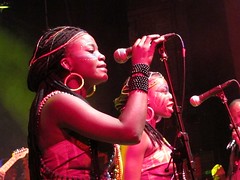 There were so many great songs, but one of Seun's newer songs, Rise, stood out. While most of the grooves were uptempo, Rise started with a cool, mellow funk groove and mournful horn lines. Here, he followed Fela's style and riffed on political/social themes while the band played: "Government does not represent people, they represent big business." While he spoke of Africa, he made the connection between there and the US. Drawing a parallel between African debt and our banking crisis, he declared it the "same shit, different style". His sly tone and cadence conjured Fela for us.
There were so many great songs, but one of Seun's newer songs, Rise, stood out. While most of the grooves were uptempo, Rise started with a cool, mellow funk groove and mournful horn lines. Here, he followed Fela's style and riffed on political/social themes while the band played: "Government does not represent people, they represent big business." While he spoke of Africa, he made the connection between there and the US. Drawing a parallel between African debt and our banking crisis, he declared it the "same shit, different style". His sly tone and cadence conjured Fela for us.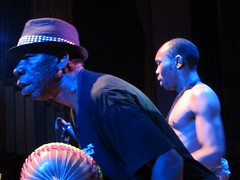 In constant motion, his dancing style was also familiar. Part spastic surrender to the polyrhythms and part storytelling mime, he embodied and channeled the songs' spirits. But while Seun held court in the center, the rest of the band were anything but passive. Just as each found a space in the groove to fit their beat, their notes, or their fill, each band member created his own performance space through dance, singing, or eye contact.
In constant motion, his dancing style was also familiar. Part spastic surrender to the polyrhythms and part storytelling mime, he embodied and channeled the songs' spirits. But while Seun held court in the center, the rest of the band were anything but passive. Just as each found a space in the groove to fit their beat, their notes, or their fill, each band member created his own performance space through dance, singing, or eye contact. In particular, the axatse player was incredibly dynamic. He danced and lunged, all while keeping his beaded gourd in time. As he mouthed the words and gestured, he interacted in turn with the audience he could see. In the middle of a pounding rhythm and dance party joy, when he made eye contact, he created a moment of personal connection.
In particular, the axatse player was incredibly dynamic. He danced and lunged, all while keeping his beaded gourd in time. As he mouthed the words and gestured, he interacted in turn with the audience he could see. In the middle of a pounding rhythm and dance party joy, when he made eye contact, he created a moment of personal connection. Aside from the pair of beautiful dancers, Egypt 80's stage management also contributed to the energy. The horn section were lined up in the house right back corner. But when they traded off leads, the soloist came down to center stage to garner full attention. So, there was a constant movement of players coming in and out. Even Seun dropped to the horn line when someone else soloed.
Aside from the pair of beautiful dancers, Egypt 80's stage management also contributed to the energy. The horn section were lined up in the house right back corner. But when they traded off leads, the soloist came down to center stage to garner full attention. So, there was a constant movement of players coming in and out. Even Seun dropped to the horn line when someone else soloed.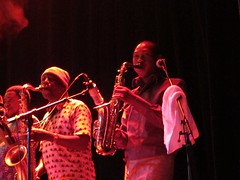 There are plenty of hot bands putting on great shows, but at the end of Egypt 80's 2:20 minute set, I felt grateful that I had caught this show. The music and message were moving, the grooves demanded a night of dancing, and we all formed a connection to a distant time and place as the band raise both Fela's Africa of the past and their own vibrant sound of now.
There are plenty of hot bands putting on great shows, but at the end of Egypt 80's 2:20 minute set, I felt grateful that I had caught this show. The music and message were moving, the grooves demanded a night of dancing, and we all formed a connection to a distant time and place as the band raise both Fela's Africa of the past and their own vibrant sound of now.Many more photos on my Flickr.




